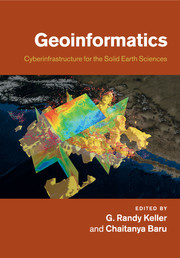List of contributors; Preface; Introduction: 1. Science needs and challenges for geoinformatics G. Randy Keller; 2. Introduction to IT concepts and challenges Chaitanya Baru; Part I. Case Studies from Other Disciplines: 3. Semantic cyberinfrastructure: the virtual solar-terrestrial observatory Peter Fox and Deborah L. McGuinness; 4. Cyberinfrastructures for life sciences and biomedicine Sriram Krishnan and Ravi Madduri; Part II. Modeling Software and Community Codes: 5. Development, verification and maintenance of computational software in geodynamics Michael Gurnis, Walter Landry, Eh Tan, Luis Armendariz, Leif Strand and Michael Aivazis; 6. Parallel finite element modeling of multi-timescale faulting and lithospheric deformation in the western US Mian Liu, Youqing Yang, Qingsong Li, Gang Luo and Huai Zhang; 7. Next-generation plate-tectonic reconstructions using GPlates James A. Boyden, R. Dietmar Müller, Michael Gurnis, Trond H. Torsvik, James A. Clark, Mark Turner, Hamish Ivey-Law, Robin J. Watson and John S. Cannon; Part III. Visualization and Data Representation: 8. Visualization of seismic model data Amit Chourasia; 9. The UNAVCO GEON Integrated Data Viewer for exploration, analysis, and integration of geoscience data Stuart Wier and Charles Meertens; Part IV. Knowledge Management and Data Integration: 10. Data and tools for geologic timelines and timescales Peter Sadler and Cinzia Cervato; 11. Modeling geodynamic processes with ontologies Hassan Babaie; Part V. Web Services and Scientific Workflows: 12. Service orientation in the design of a community hydrologic information system Ilya Zaslavsky and David Maidment; 13. Web services for seismic data archives Robert Casey and Timothy Ahern; 14. Development of robust data system for gravity and magnetic anomaly data: a case study of a community-based effort for point data Raed Aldouri and G. Randy Keller; 15. Scientific workflows for the geosciences: an emerging approach to building integrated data analysis systems Ilkay Altintas, Daniel Crawl and Christopher Crosby; 16. Online access and processing of Lidar topography data Christopher Crosby, J. Ramon Arrowsmith, Viswanath Nandigam and Chaitanya Baru; 17. Use of abstraction to support geoscientists' understanding and production of scientific artifacts Ann Gates, Paulo Pinheiro da Silva, Leonardo Salayandia, Omar Ochoa, Aida Gandara and Nicholas Del Rio; Part VI. Emerging International and Other Efforts: 18. It's not your data, it's everyone's: the benefits of a corporate approach to scientific information Ian Jackson and Richard Hughes; 19. TOPO-EUROPE and cyberinfrastructure: quantifying coupled deep earth-surface processes in 4D Sierd Cloetingh and H. P. Bunge; 20. OneGeology – from concept to global project Ian Jackson; 21. Geoinformatics developments in Germany Jens Klump, Joachim Wächter, Peter Löwe, Ralf Bill and Matthias Lendholt; 22. iGEON: networking the Indian geosciences community through GEON K. V. Subbarao, Arun Agarwal, Rajeev Wankar and Chaitanya Baru; 23. Geoinformatics in the public service: building a cyberinfrastructure across the geological surveys M. Lee Allison, Linda C. Gundersen and Stephen M. Richard; 24. Application of the U.S. geoscience information network to deploying a national geothermal data system Stephen M. Richard, Ryan Clark and Wolfgang Grunberg; Index.




